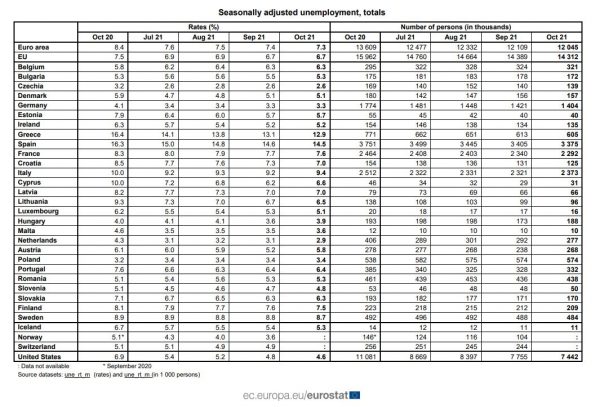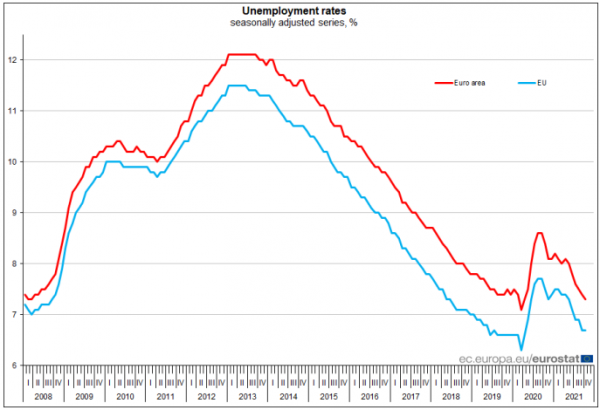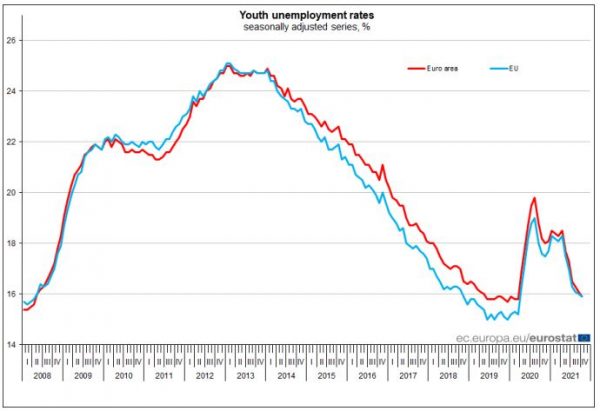
In October 2021, the euro area seasonally-adjusted unemployment rate was 7.3%, down from 7.4% in September 2021 and from 8.4% in October 2020. The EU unemployment rate was 6.7% in October 2021, stable compared with September 2021 and down from 7.5% in October 2020. These figures are published by Eurostat, the statistical office of the European Union. 
At the same time, there was a large drop in unemployment in Greece to 12.9% year on year from 16.4% in the corresponding period last year.
Eurostat estimates that 14.312 million men and women in the EU, of whom 12.045 million in the euro area, were unemployed in October 2021. Compared with September 2021, the number of persons unemployed decreased by 77 000 in the EU and by 64 000 in the euro area. Compared with October 2020, unemployment decreased by 1.650 million in the EU and by 1.564 million in the euro area.
Youth unemployment
In October 2021, 2.905 million young persons (under 25) were unemployed in the EU, of whom 2.367 million were in the euro area. In October 2021, the youth unemployment rate was 15.9% in both the EU and the euro area, down from 16.0% in the EU and from 16.1% in the euro area in the previous month. Compared with September 2021, youth unemployment decreased by 2 000 in the EU and by 9 000 in the euro area. Compared with October 2020, youth unemployment decreased by 165 000 in both the EU and the euro area.
Unemployment by gender
In October 2021, the unemployment rate for women was 7.0% in the EU, down from 7.1% in September 2021. The unemployment rate for men was 6.4% in October 2021, down from 6.5% in September 2021. In the euro area, the unemployment rate for women decreased from 7.8% in September 2021 to 7.7% in October 2021, while the unemployment rate for men remained stable at 7.0%.
Additional labour market indicators
These estimates are based on the globally used International Labour Organisation (ILO) standard definition of unemployment, which counts as unemployed people without a job who have been actively seeking work in the last four weeks and are available to start work within the next two weeks. The COVID-19 outbreak and the measures applied to combat it have triggered a sharp increase in the number of claims for unemployment benefits across the EU. At the same time, a significant part of those who had registered in unemployment agencies were no longer actively looking for a job or no longer available for work, for instance, if they had to take care of their children. This leads to discrepancies in the number of registered unemployed and those measured as unemployed according to the ILO definition.
To capture in full the unprecedented labour market situation triggered by the COVID-19 outbreak, the data on unemployment have been complemented by additional indicators, e.g. underemployed part-time workers, persons seeking work but not immediately available and persons available to work but not seeking, released together with LFS data for the second quarter of 2021. LFS data for the third quarter of 2021 will be released on 13 January 2022.
What is happening in Greece
Unemployment in Greece fell further in October, a decline that brought the unemployment rate below 13%, according to the data.
According to the official statistics of the EU, the seasonally adjusted unemployment rate in October fell to 12.9%, from 13.1% in September and 16.4% compared to October 2020. This level is the second highest among the 27 EU member states, behind only 14.5% of Spain.
However, unemployment under the age of 25 did not decline, as it rose from 28.1% in September to 33.2% in October, a percentage that ranks Greece first, with Spain following with a percentage of 30.3%.
Regarding both sexes, the percentage of unemployed men remained at 9.8% in October, while among women it remained relatively high, but fell to 16.8%, from 17.1% in September.
Latest News

New Exposé by Domumento Reveals Nefarious Triangular Link of ‘Black Money’ with New Democracy, Blue Skies, & Truth Team
The latest exposé by the Documentonews.gr news site lays bare what appears to be a surreptitious path of indirect financing of ND through the business sector—transactions that, as widely understood, rarely occur without expectations of reciprocal benefit

PM Meloni Meets Vice President Vance in Rome Signalling Optimism on Ukraine Talks
Meloni emphasized the strength and strategic value of the Italy-U.S. partnership.

Airbnb: Greece’s Short-Term Rentals Dip in March Amid Easter Shift
Data from analytics firm AirDNA shows that average occupancy for short-term rentals dropped to 45% in March, down from 49% the same month last year.

Easter Week in Greece: Holy Friday in Orthodoxy Today
At the Vespers service on Friday evening the image of Christ is removed from the Cross and wrapped in a white cloth

Meloni and Trump Meet in Washington, Vow to Strengthen Western Ties
“I am 100% sure there will be no problems reaching a deal on tariffs with the EU—none whatsoever,” Trump stressed.

ECB Cuts Interest Rates by 25 Basis Points in Expected Move
The ECB’s Governing Council opted to lower the deposit facility rate—the benchmark for signaling monetary policy direction—citing an updated assessment of inflation prospects, the dynamics of underlying inflation, and the strength of monetary policy transmission.

Current Account Deficit Fell by €573.2ml Feb. 2025: BoG
The improvement of Greece’s current account was mainly attributed to a more robust balance of goods and, to a lesser extent, an improved primary income account

Hellenic Food Authority Issues Food Safety Tips for Easter
Food safety tips on how to make sure your lamb has been properly inspected and your eggs stay fresh.

Greek Kiwifruit Exports Smash 200,000-Ton Mark, Setting New Record
According to data by the Association of Greek Fruit, Vegetable and Juice Exporters, Incofruit Hellas, between September 1, 2024, and April 17, 2025, kiwifruit exports increased by 14.2%.

Easter Tourism Boom: Greece Sees 18.3% Surge in Hotel Bookings
Among foreign markets, Israel has emerged as the biggest growth driver, with hotel bookings more than doubling—up 178.5% year-on-year.









![Πλημμύρες: Σημειώθηκαν σε επίπεδα ρεκόρ στην Ευρώπη το 2024 [γράφημα]](https://www.ot.gr/wp-content/uploads/2025/04/FLOOD_HUNGRY-90x90.jpg)





![Airbnb: Πτωτικά κινήθηκε η ζήτηση τον Μάρτιο – Τι δείχνουν τα στοιχεία [γράφημα]](https://www.ot.gr/wp-content/uploads/2024/07/airbnb-gba8e58468_1280-1-90x90.jpg)


























 Αριθμός Πιστοποίησης
Αριθμός Πιστοποίησης